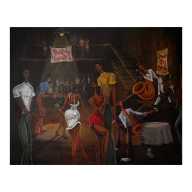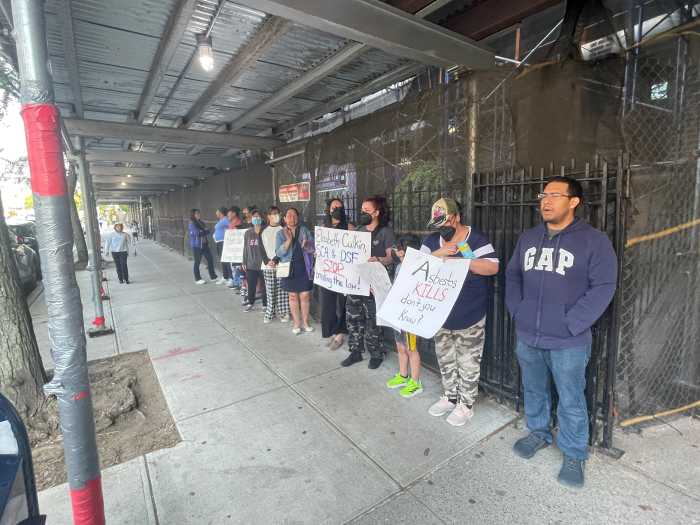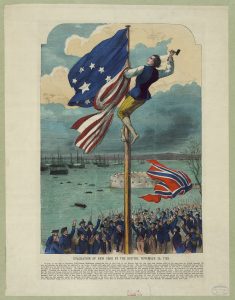
John Van Arsdale replaces the Union Jack with the Stars and Stripes on Evacuation Day, Nov. 25, 1783.
Before Thanksgiving, before Black Friday, before Small Business Saturday, the last week of November marked a holiday celebrating something even more American than the Pilgrims, consumerism or Main Street: Evacuation Day — the day we finally kicked the British back across the Pond.
On Nov. 25, 1783, the last British forces departed the newly United States from Lower Manhattan, which they had occupied for seven years since George Washington’s retreat from the city following the Battle of Brooklyn.
Washington made his triumphant return to Downtown that same day, and he sent orders ahead that the Stars and Stripes should be flying above Bowling Green upon his arrival.
But the British — after essentially squatting in Lower Manhattan for two years after the Yorktown surrender — just had to get in one final insult. Those cheeky Brits had the audacity to nail the Union Jack to the top of the flag pole — and then grease the pole — before they departed.
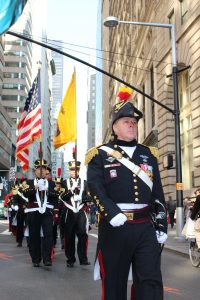
Several patriots tried and failed to reach the top of the pole and tear down the hated Union Jack, but one war veteran named John Van Arsdale had a better grasp of the pole, and the moment, than the others.
Van Arsdale had nearly died on one of the notorious British prison ships anchored in New York Harbor. For the duration of the Revolutionary War, with Lower Manhattan as its continental headquarters, Britain maintained a floating gulag where American patriots were treated not as prisoners of war but as rebels against the English Crown, entitled to nothing — not even food. The horrific British prison ships — memorialized in Fort Greene, Brooklyn — killed more Americans than all the battles of the Revolutionary War combined, accounting for two thirds of colonial casualties.
As one of the fortunate 20 percent who survived the prison ships, it shouldn’t be surprising that Van Arsdale was also lucky enough to reach the top and rip down the Union Jack — and replace it with the American flag before the British fleet managed to sail out of sight.
For decades Americans celebrated Evacuation Day, which effectively marked the end of the Revolutionary War, nearly as fervently as the Fourth of July, which commemorated its start. But interest faded during the 19th century — especially after Thanksgiving took over the last week of November after the Civil War. Formal celebrations ended entirely in 1916 when the United States entered World War I as an ally of Great Britain.
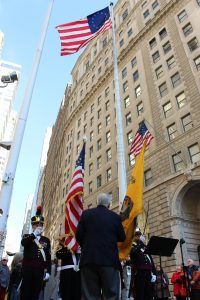
But a group of Downtown history buffs is trying to revive the “forgotten holiday” in Lower Manhattan, and gathered at Bowling Green on Nov. 25 to celebrate America’s victory over tyranny.
“It was here where our democracy was born, when they raised the flag in 1783,” said James Kaplan, president of the Lower Manhattan Historical Society, who led the charge to revive Evacuation Day.
This was the society’s second observance of the end of British occupation, and featured a procession from St. Paul’s Chapel to Bowling Green by the Veteran Corps of Artillery, the nation’s oldest continuously active military unit, formed in 1790 by Van Arsdale and other Revolutionary War veterans to guard against any possible return of the defeated redcoats.
Arriving to the tune of “Yankee Doodle” on fife and drum, the VCA preformed a rather more polite reenactment of the flag incident of the original Evacuation Day. Commandant Col. Stephen Ryan symbolically handed a neatly folded Union Jack to British military representative Capt. John Conlin of the 6th Gurkha Regiment, before hoisting a 13-star American flag over Bowling Green.
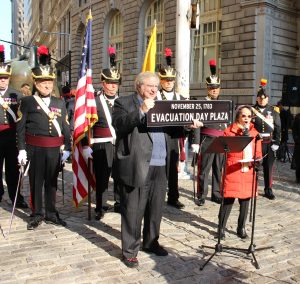
Councilmember Margaret Chin and Lower Manhattan Historical Society Society president James Kaplan unveil the “Evacuation Day Plaza” sign co-naming the northern tip of Bowling Green.
Arthur Piccolo, co-founder of the Lower Manhattan Historical Society and chairman of the Bowling Green Association, used the occasion to bestow the group’s Peppercorn Award to VCA public affairs officer Lt. Col. Allen Millman, who organized the unit’s participation this year, and served as emcee for the event.
Piccolo also took video of the ceremonies for an Evacuation Day documentary for the Lower Manhattan Historical Society.
Then Downtown Councilmember Margaret Chin joined Kaplan in unveiling a street sign created for the proposed co-naming of the northern tip of Bowling Green as “Evacuation Day Plaza.” The Council is expected to approve the measure before the end of the year.
Chin said she hoped turnout for the celebration would be even better next year, pointing out that even in 1893 — 30 years after Thanksgiving stole its thunder — 10,000 New Yorkers gathered in Lower Manhattan to celebrate Evacuation Day.
“This holiday deserves to be observed,” he said.
— BY BILL EGBERT
Author Sarah Vowell made an impassioned and hilarious plea to revive Evacuation Day on the Daily Show in 2011:
Get More: Comedy Central,Funny Videos,Funny TV Shows


























